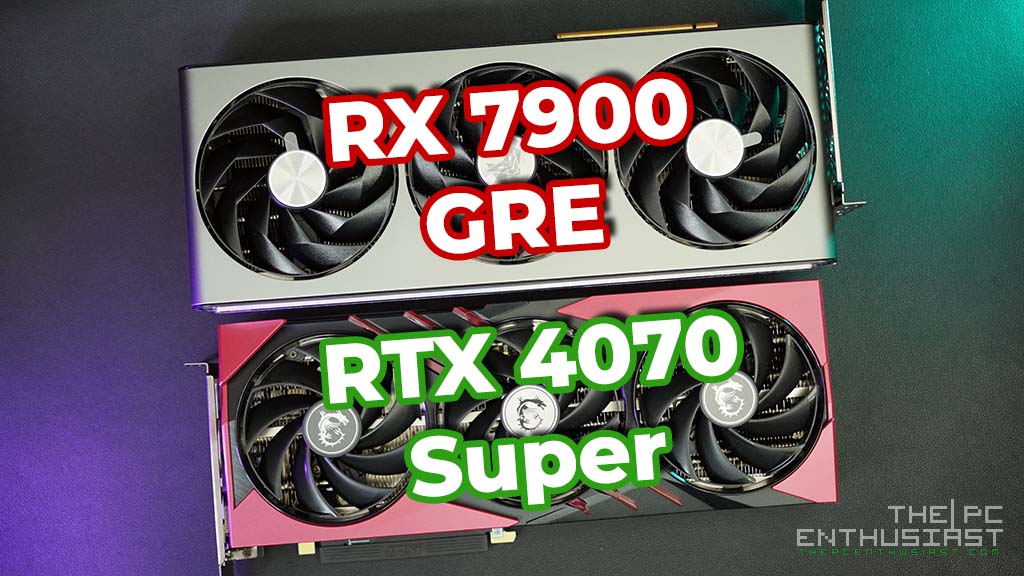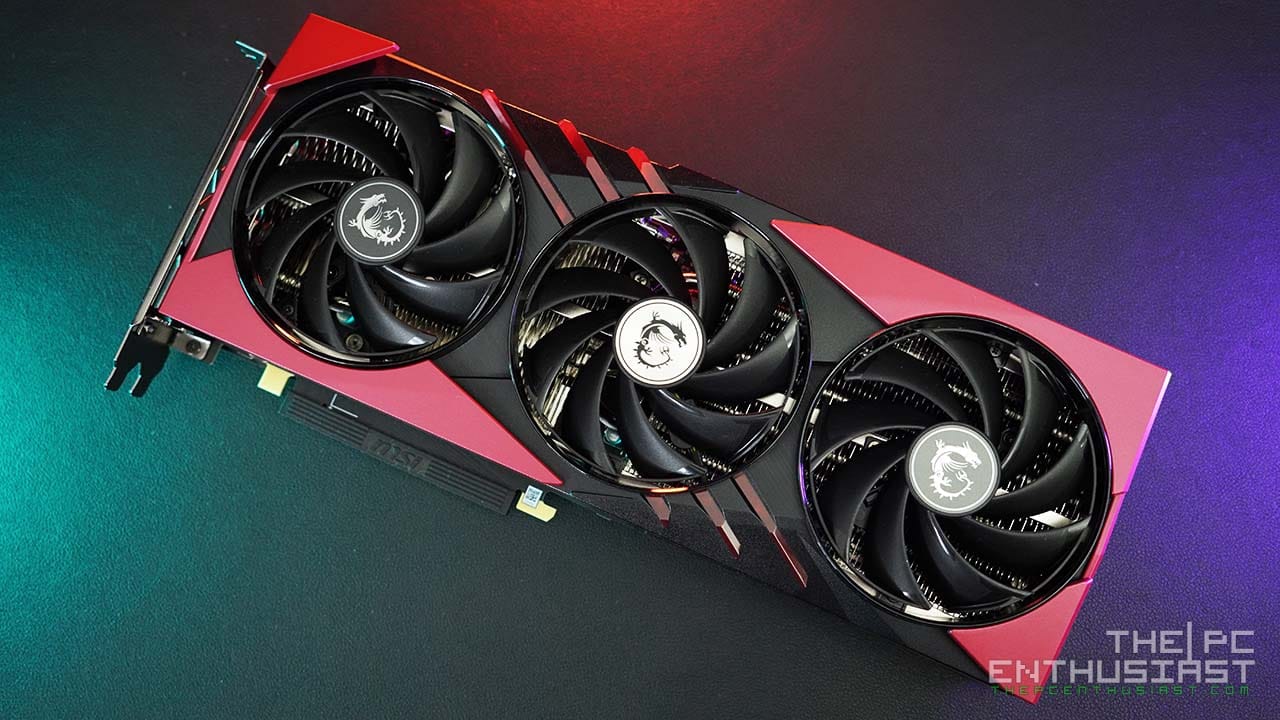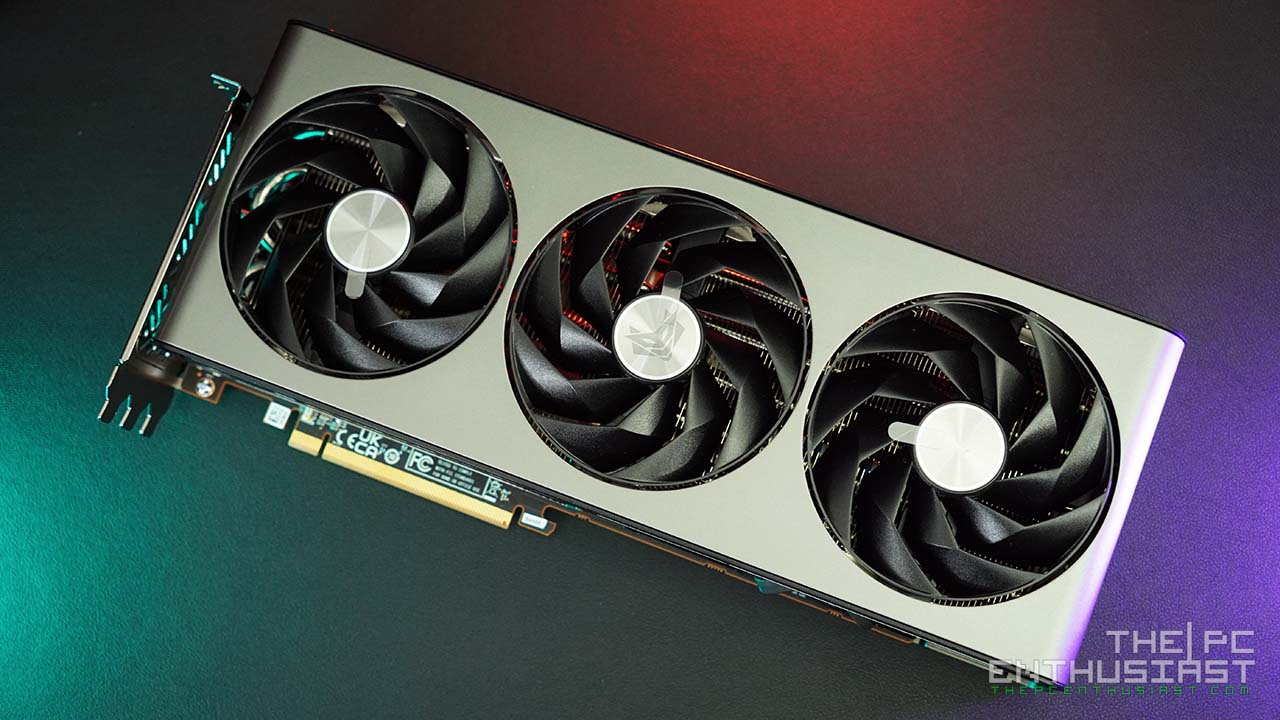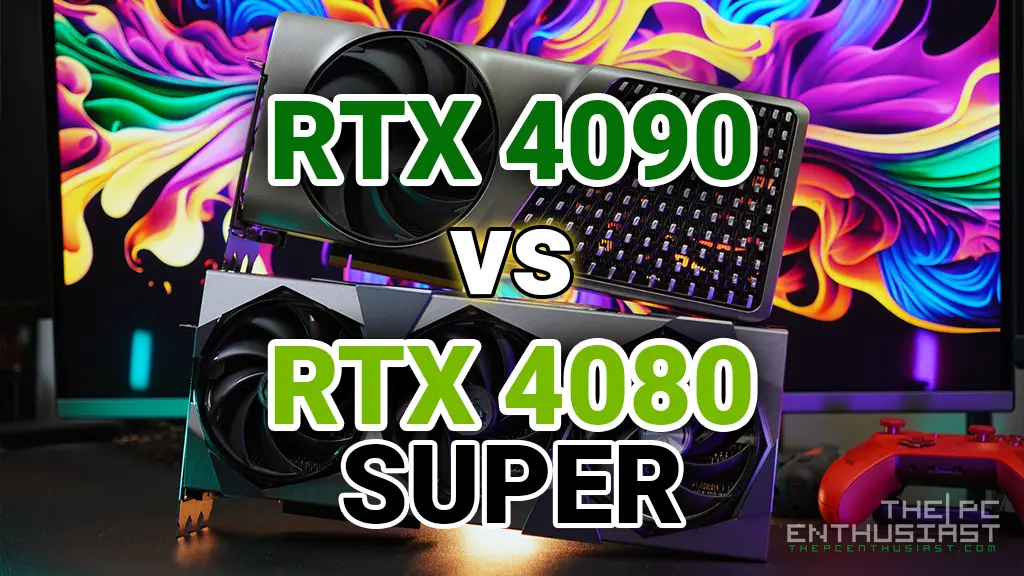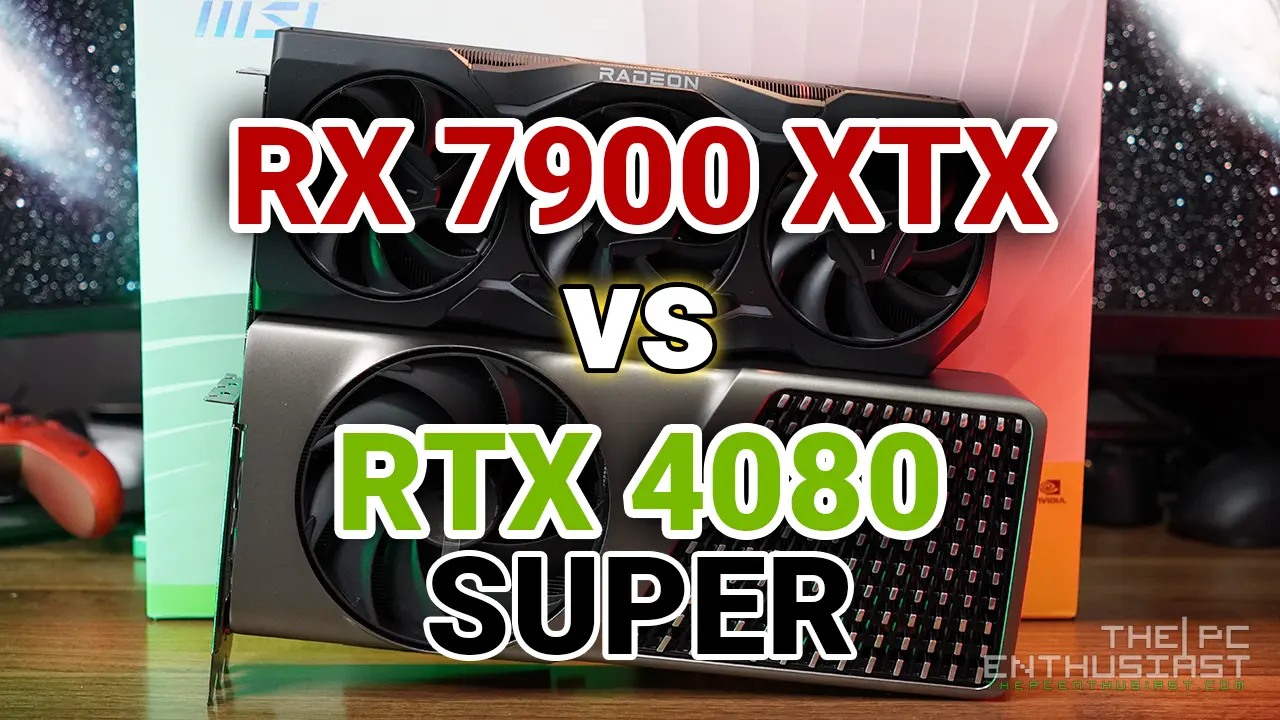Today, we’ll compare two upper mid-range GPUs, one from the green team and another from the red team. These two GPUs are the GeForce RTX 4070 Ti and Radeon RX 7900 XT. Both are excellent GPUs for 1440p and can even handle games at 4K, depending on the settings. As of writing, the RX 7900 XT and RTX 4070 Ti are in the same price range (more or less), with the latter being a bit pricier than AMD’s GPU. Should you buy an RTX 4070 Ti for 1440p gaming? Or get the cheaper RX 7900 XT instead? If you are torn between these two GPUs, please continue reading our RX 7900 XT vs RTX 4070 Ti comparison below.
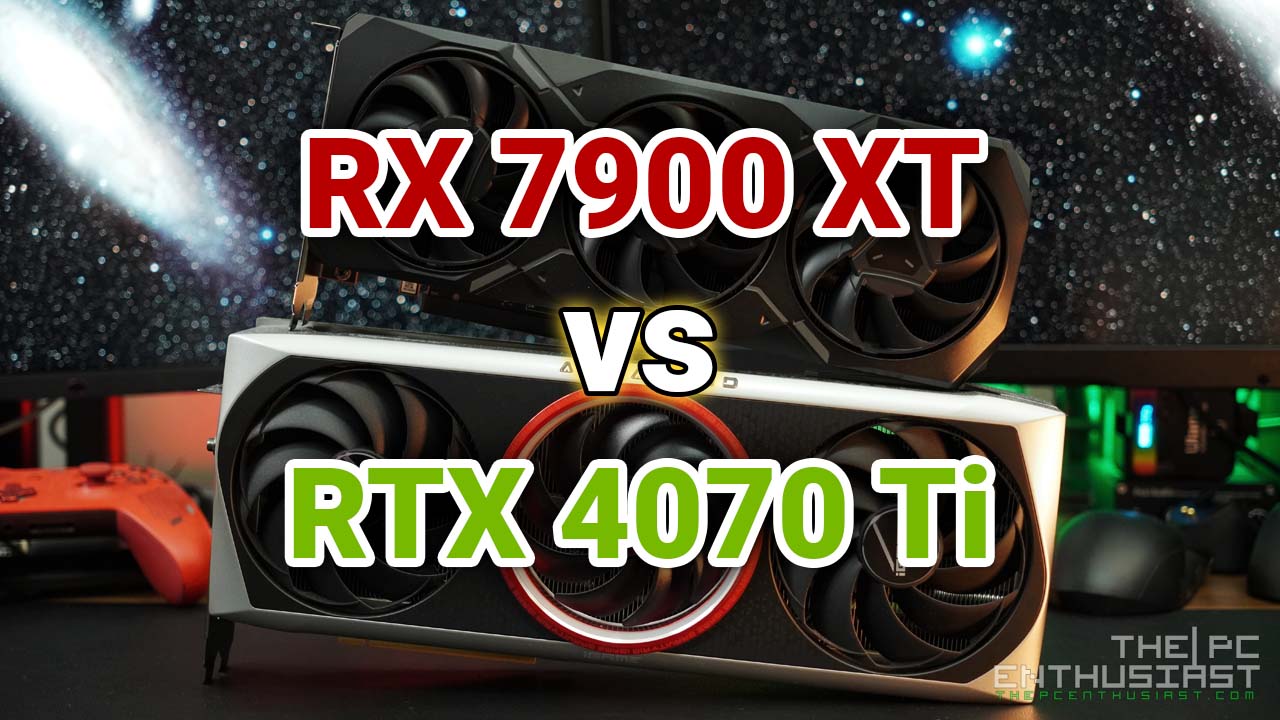
AMD Radeon RX 7900 XT vs NVIDIA GeForce RTX 4070 Ti
Before I show you some benchmarks, let’s quickly recap the specs of each GPU. The RX 7900 XT, not to be confused with the 7900 XTX, is based on AMD’s RDNA 3 architecture, and similar to the 7900 series, it also uses a chiplet design. AMD used a 5nm TSMC process for its Graphics Compute Die (GDC) and a 6nm process for the Memory Cache Die (MCD). Its. Navi 31 GPU has 5376 Stream Processors paired with 20GB GDDR6 VRAM.
On the other hand, NVIDIA’s RTX 4070 Ti is based on the AD104 GPU and has 7,680 CUDA Cores providing 40 FP32 Shader-TFLOPS of power for rendering traditional rasterized graphics; 240 4th gen Tensor Cores offering 641 Tensor-TFLOPS (with Sparsity) for AI processing and DLSS; 60 3rd gen Ada RT Cores capable of 93 RT-TFLOPS for powering next-generation ray-traced graphics; and 12GB of GDDR6X memory.
In this current generation of GPUs, NVIDIA is still ahead when it comes to ray tracing technology and upscaling solutions. Nevertheless, AMD is catching up, as they recently released FSR 3. However, we won’t know for sure if AMD can match NVIDIA’s ray tracing and upscaling technology by the time the next generation of GPUs is released.
Other Features
Usually, AMD has more VRAM on its GPU, although they use the “slower” GDDR6 instead of the faster GDDR6X memory. However, having a faster or larger VRAM doesn’t necessarily result in one graphics card performing better than the other. Of course, if the game or application you run heavily relies on the graphics card’s VRAM, the higher the VRAM is usually better.
While both the RTX 4070 Ti and RX 7900 XT support AV1 encoding, aside from ray tracing and upscaling, NVIDIA has a trick called DLSS 2 AI Frame Generation under its sleeve. NVIDIA also released DLSS 3.5 or Ray Reconstruction. On the software side of things, NVIDIA is ahead. But AMD is catching up with its FSR 3. However, only two games currently have this feature, Forspoken and Immortals on Aveum.
Below are the specifications of the RTX 4070 Ti and RX 7900 XT GPUs. After that, let’s get straight to the benchmark results.
GeForce RTX 4070 Ti vs Radeon RX 7900 XT Specifications
| Graphics Card | GeForce RTX 4070 Ti | AMD Radeon RX 7900 XT |
|---|---|---|
| Fabrication Process | TSMC 4N NVIDIA Custom Process | GCD: TSMC 5nm MCD: TSMC 6nm |
| Transistor Count | 35.8 billion | 58 billion |
| Architecture | Ada Lovelace | RDNA3 |
| GPU | AD104 | Navi 31 |
| CUDA Cores / Stream Processors | 7680 | 5376 |
| RT Cores / Ray Accelerators | 60 | 84 |
| Texture Units | 240 | 336 |
| ROPs | 80 | 192 |
| Boost Clock | 2610 MHz | 2400 MHz |
| Memory Clock | 10500 MHz | 2500 MHz |
| Effective Memory | 21 Gbps | 20 Gbps |
| L2 / Infinity Cache | 49.1 MB | 80 MB |
| VRAM Size/Type | 12 GB GDDR6X | 20 GB GDDR6 |
| Memory Interface | 192-bit | 320-bit |
| Total Memory Bandwidth | 504 GB/s | 800 GB/s |
| Texture Rate | 626 Gigatexels/sec | 804.4 Gigatexels/sec |
| Connectors | 3x DisplayPort, 1x HDMI | 2x DisplayPort, USB-C, HDMI |
| Minimum Power Supply | 700 W | 750 W |
| TGP / TDP | 285 W | 315 W |
| PCI Express Interface | Gen 4 | Gen 4 |
| Release Date | Jan 2023 | Dec 2022 |
| Launch Price | $799 | $899 |
Check the latest pricing and availability: (#ad)
GeForce RTX 4070 Ti graphic cards are available on Amazon here.
Radeon RX 7900 XT graphics cards are available on Amazon here.
Test System Used
| Operating System | Windows 11 Pro |
| Processor | AMD Ryzen 7 7700X |
| Motherboard | MSI MPG X670E Carbon WiFi |
| Memory | Corsair Vengeance RGB DDR5-6000MHz CL30 AMD EXPO |
| Graphics Card | AMD Radeon RX 7900 XT iGame GeForce RTX 4070 Ti |
| OS Drive | MSI Spatium M480 Play |
| Game Drive | SanDisk Extreme PRO Portable SSD V2 and Extreme Portable SSD V2 |
| Power Supply | MSI MPG A1000G PCIE5 |
| Chassis | MSI MPG Velox 100P Airflow |
| Monitor | MSI Optix MPG321UR-QD 4K 144Hz |
GeForce RTX 4070 Ti vs Radeon RX 7900 XT – Synthetic Benchmarks
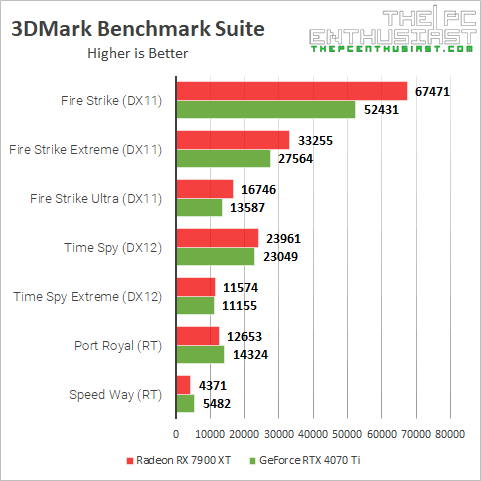
The Radeon RX 7900 XT is generally faster than the RTX 4070 Ti in the synthetic benchmarks with rasterization only. We can see a noticeable performance difference in the Fire Strike benchmark suite. However, the RTX 4070 Ti slightly outperformed the RX 7900 XT in Port Royal and Speed Way benchmarks.
Both the Port Royal and Speed Way are primarily ray tracing benchmarks, with the latter being the newer test. Speed Way is “an ideal benchmark for comparing the DirectX 12 Ultimate performance of the latest graphics cards”. This is why the RX 7900 XT fell a bit behind since ray tracing is not AMD’s forte, at least for now.
These are just synthetic benchmarks and are graphics scores. So, let’s find out next how these two GPUs compare in actual games.
RTX 4070 vs RX 7800 XT – RT and DLSS/FSR Game Benchmarks
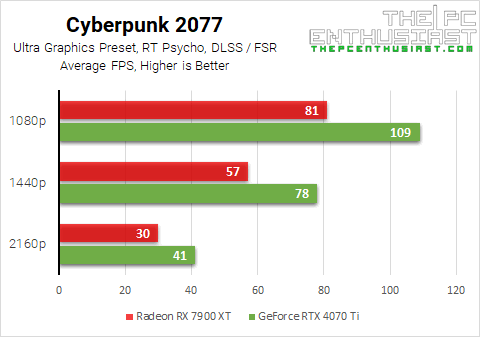
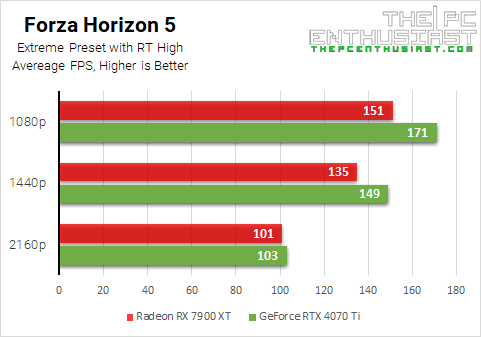

I only tested three games with ray tracing enabled since I knew NVIDIA would end up on top. As you can see from the results above, games with ray tracing perform better with an NVIDIA RTX 40 GPU; in this case, the RTX 4070 Ti. You can still get decent frame rates with the RX 7900 XT when ray tracing is enabled, but you will need to adjust and lower the graphics quality to get higher frame rates.
Note that Forza Horizon 5’s ray tracing is less graphics intensive than the other games. Only the cars’ surfaces have ray-traced reflections, and there is no DLSS or FRS. No wonder the RX 7900 XT is just a couple of frames slower than the RTX 4070 Ti in 4K resolution.
When it comes to upscaling technology, NVIDIA GPUs can use both FSR 2.0 and DLSS. Meanwhile, AMD GPUs can only use FSR. Regarding quality, though, NVIDIA’s DLSS is overall superior to AMD’s upscaling technology. Again, I wouldn’t be surprised since NVIDIA was the first to implement and use ray tracing and DLSS on their GPUs. I just hope AMD can catch up quickly, and I’m hoping AMD’s FSR 3 will significantly improve, especially in graphics quality and fidelity.
Now, let’s check out how their performance differs in traditional rasterization.
RTX 4070 vs RX 7800 XT – Rasterization Game Benchmarks
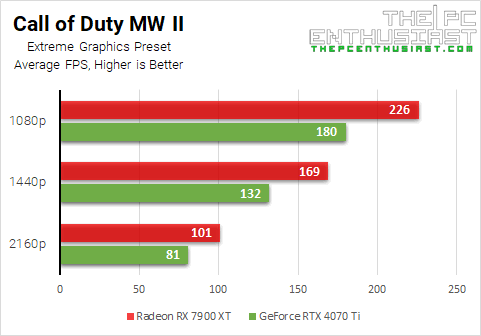
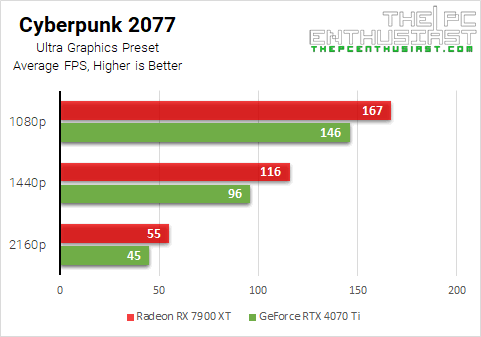
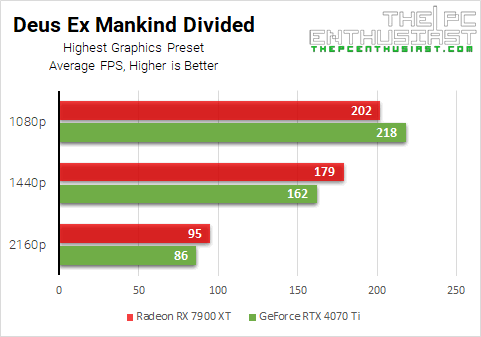

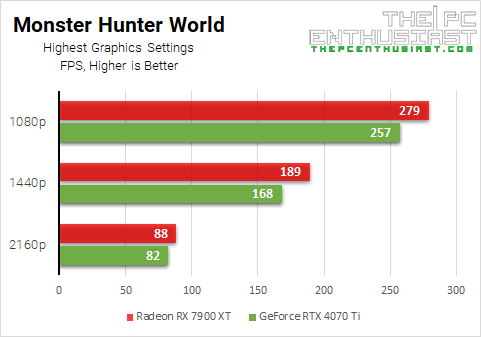
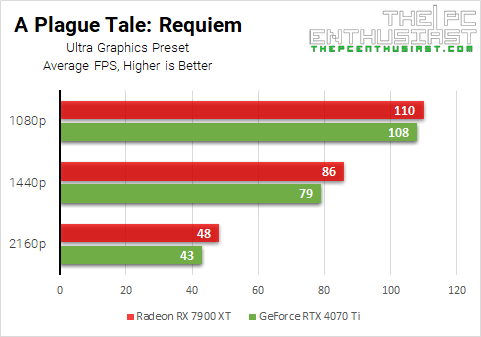
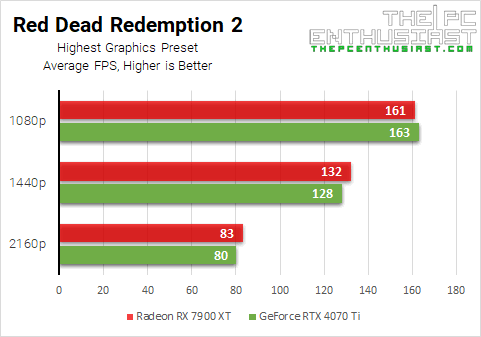


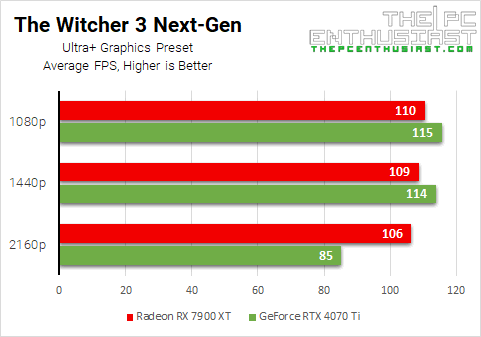
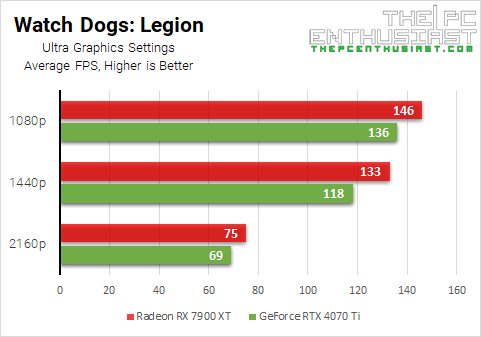
In the rasterization test, the Radeon RX 7900 XT is generally faster than the RTX 4070 Ti. If a game is AMD-sponsored or favors AMD GPUs, expect the RX 7900 XT to perform better, sometimes substantially. For example, in Call of Duty Modern Warfare II, the RX 7900 XT performed noticeably faster than the RTX 4070 Ti.
I was expecting the RTX 4070 Ti to outperform the RX 7900 XT in The Witcher 3. However, I did not expect the RX 7900 XT to perform well in Cyberpunk 2077, even outperforming the RTX 4070 Ti.
Cyberpunk 2077 is an NVIDIA-sponsored title. And most of the new GPU technology NVIDIA releases, it’s usually CP2077 that gets the first treatment. This game is basically like NVIDIA’s “tech demo”. But surprisingly, AMD’s RX 7900 XT performed well on this game, though only in pure rasterization.
Let’s combine these results and see the general picture.
Summary Results

The 13-game average above only covers the traditional rasterization, but Forza Horizon 5 with RT enabled was included. I did not include Cyberpunk 2077 and The Witcher 3’s ray tracing results since it would skew the results toward the RTX 4070’s favor.
When it comes to raw performance, the Radeon RX 7900 XT wins, but only by a small margin. Honestly, I was expecting that the RTX 4070 Ti would outperform the RX 7900 XT in both rasterization and ray tracing. What is surprising though is that there’s only little difference between the two GPUs in raw performance.
If I were to play games without benchmarking or seeing the FPS counter, it would be very difficult to tell which GPU is running. Both are performing close to each other, with the AMD RX 7900 XT leading by a few FPS higher.
AMD’s Radeon RX 7900 XT is only around 3% faster on average in 1080p. The performance difference slightly increased at 1440p, with the RX 7900 XT leading by 7% on average. Only in 4K resolution can we see a somewhat substantial difference. The RX 7900 XT is around 10% faster on average than the RTX 4070 Ti in 4K.
Now that we know their difference in terms of performance, let’s compare their current pricing next.
Price Difference and Availability
NVIDIA’s MSRP for the GeForce RTX 4070 Ti is $799, while AMD’s MSRP for the Radeon RX 7900 XT is $899. However, these GPUs have been in the market for quite some time. AMD is known to (quickly) adjust the pricing of its products. If we just base it on the launch price, the RX 7900 XT is the more expensive GPU. But when I check the current market prices of these GPUs, it seems the RTX 4070 Ti has the more expensive graphics cards.
The cheapest RX 7900 XT graphics card I could find is currently priced at $749.99. These are the Sapphire Pulse RX 7900 XT and Powercolor Hellhound RX 7900 XT graphics cards. Meanwhile, the cheapest RTX 4070 Ti graphics card I found is the Zotac RTX 4070 Ti Trinity OC, currently retailing for $769.99.
Most RTX 4070 Ti cards are either priced at $799 or above $800, with the premium ones priced at around $840 to $870. And believe it or not, Asus’ ROG Strix RTX 4070 Ti currently costs $980! Although, there is also an RX 7900 XT card that is priced above $900. Can you guess what it is? It’s none other than the Asus TUF Radeon RX 7900 XT, currently retailing for around $971.
Just note that these prices were correct at the time and are not permanent; they will change. It’s just a matter of when.
Prices seem to be all over the place, and you can expect that the more premium cards are priced higher and less likely to be discounted. Remember, GPU prices tend to change. AMD was the recent one to adjust its GPUs’ pricing. So be sure to check the current price, as it may affect your decision.
Check the latest pricing and availability: (#ad)
Radeon RX 7900 XT graphic cards are available on Amazon here.
GeForce RTX 4070 Ti graphics cards are available on Amazon here.
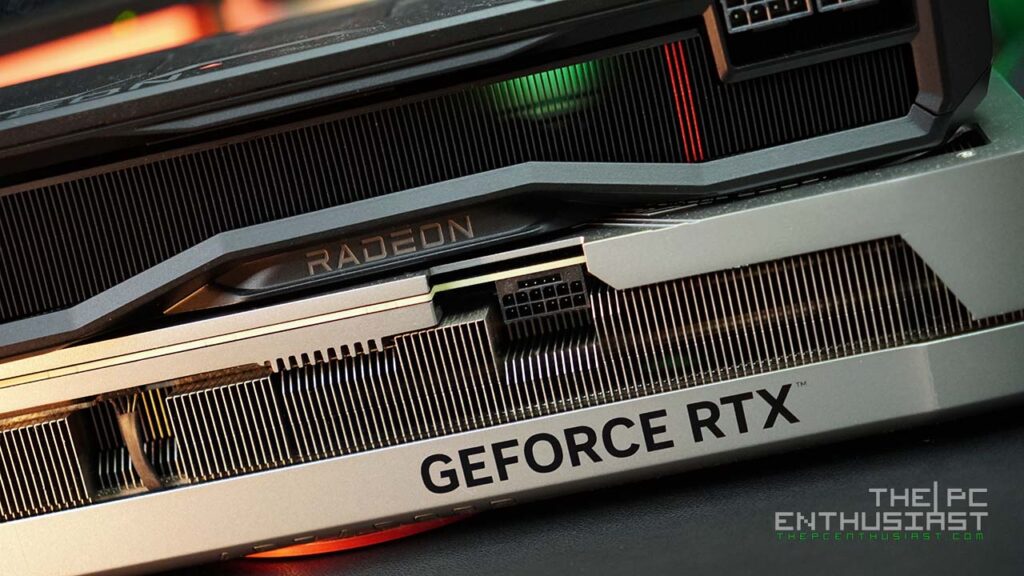
Radeon RX 7900 XT vs GeForce RTX 4070 Ti Conclusion
This comparison reminds me of my recent article, RX 7800 XT vs RTX 4070. The results I got are quite similar, with AMD’s GPU being slightly faster than NVIDIA’s. However, with the current price adjustment, AMD’s GPUs have become more attractive than NVIDIA’s offering.
Let’s ignore the more premium cards first and just focus on the cheapest or base-priced cards currently available. With the premium cards, you are just paying more for the card’s aesthetics rather than performance.
So, between a $750 RX 7900 XT and a $760 RTX 4070 Ti, it is quite a difficult choice to make. There’s only a $10 difference, and the performance difference is not that huge. If we factor in ray tracing, the RTX 4070 Ti would be the ideal card to get.
Of course, I expect AMD fans would choose the RX 7900 XT over the RTX 4070 Ti, and the same can be said for NVIDIA fans. But how about those in between who have no brand loyalty and just want the best GPU for their setup or the GPU that is worth their money?
I’ll highlight some reasons why you should choose one GPU over the other.
Reasons to Choose GeForce RTX 4070 Ti:
- It is an excellent GPU for 1440p gaming;
- Better ray tracing performance and upscaling technology;
- It is more efficient and consumes less power than the RX 7900 XT, though you do need to use the 16-pin 12VHPWR connector;
- Get access to DLSS 3 Frame Generation, making gameplay smoother, and the recently released DLSS 3.5 Ray Reconstruction;
- It has a better video encoder (NVENC) with AV1 support;
- If the software/applications you use can take advantage of NVIDIA’s GPU acceleration or CUDA technology,
- If you spot an RTX 4070 Ti with a $760 price tag or less.
Reasons to Choose Radeon RX 7900 XT:
- It is generally cheaper than the RTX 4070 Ti;
- It is also an excellent GPU for 1440p gaming and can drive games at 4K as well;
- If you don’t want to use the 16-pin 12VHPWR connector or don’t want to upgrade your current PSU;
- It has better rasterization performance while costing cheaper or similar, depending on the graphics card model;
- If ray tracing and/or upscaling technology is not a big issue for you,
- It has significantly more VRAM, and if you use software or applications that would benefit from it.
The main strength of AMD’s Radeon RX 7900 XT is its raw performance and competitive pricing. The recent price drop of the RX 7900 XT was an excellent deal. If I am not mistaken, $750 is the lowest for an RX 7900 XT card so far.
On the other hand, NVIDIA may want to avoid AMD winning, and they could adjust the RTX 4070 Ti’s price as well. But so far, there is only one graphics card priced at $760, and we may (or may not) see other cards drop prices as well.
Finally…
Overall, I think there is no clear winner here. There’s always a compromise. However, the RX 7900 XT does have the advantage when it comes to price/performance. But the RX 7900 XT may not work for you or suit your needs, depending on your preference or how you use your PC. Some factors need to be considered as well. There’s no single answer to this since we all have different needs.
But at the end of the day, either which card you choose, both the RX 7900 XT and RTX 4070 Ti are solid graphics cards for 1440p gaming. If you want to see how the next higher GPU compares, check out our RTX 4080 vs RX 7900 XTX here.

